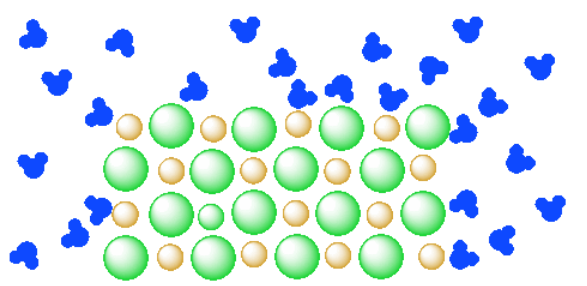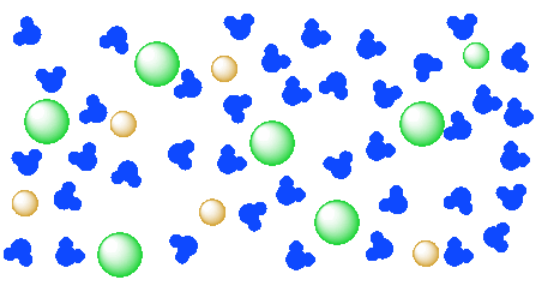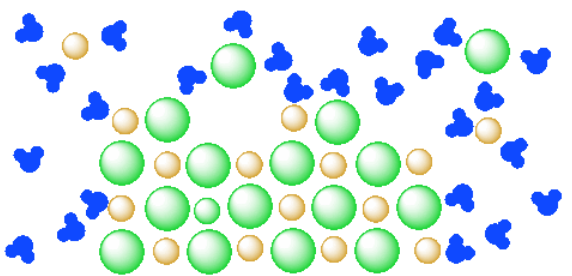3.4: Solubility
- Page ID
- 189622
One of the other general properties of ionic compounds is that they often have some solubility in water. The oceans, of course, are saltwater. In a mixture, two or more materials are mixed together but they remain essentially separate, like sand and water. You can still easily tell the difference between the sand and the water, because even if you shake them up they will separate again on their own.
In a mixture, two or more materials are mixed together but they remain essentially separate, like sand and water. You can still easily tell the difference between the sand and the water, because even if you shake them up they will separate again on their own.

In a suspension, one or more materials is mixed into a liquid, and the mixture becomes somewhat homogeneous. Instead of having easily identifiable layers, the liquid looks the same throughout. However, suspensions are generally cloudy liquids. Milk is a suspension. It contains water, fats and proteins. They may settle out into separate layers eventually, but it takes time.
In a solution, one or more materials is mixed into a liquid, and the mixture becomes a completely homogeneous liquid. Solutions are transparent, not cloudy. They may be colored or colorless, but you can always see through them. Saltwater is a solution.

You can't see chunks of salt in the solution because the salt particles are too small for you to see. The salt is separated into individual ions, surrounded by water molecules.
Of course, if you put some salt in water, it might not dissolve right away. You might have to stir it for a while.

Eventually more of the salt would dissolve in the water.

However, at some point, the system might come to "equilibrium": the water has dissolved all of the salt that it can, so the rest of the salt stays solid. This equilibrium may be "dynamic": different ions may become dissolved in the water or may be deposited from solution into the solid state. However, the overall ratio of dissolved ions to water stays the same.

Let's take a look at the idea that a given amount of water is only able to dissolve a specific amount of salt.
- In the diagram above, how many water molecules are there?
- How many units of salt (an anion and a cation) are dissolved?
- If there were only a dozen water molecules present, how many units of salt would dissolve?
- If a hundred water molecules were present, how many units of salt would dissolve?
- Answer a:
-
25 waters.
- Answer b:
-
2 units (2 anions and 2 cations).
- Answer c:
-
Half the water might only dissolve half the salt: 1 unit.
- Answer d:
-
Four times the water may dissolve four times the salt: 4 units.
Why do salts dissolve in water? Water is a molecular compound; the atoms are directly attached to each other, rather than being ions that are attracted to each other. Because of electronegativity differences, the oxygen in water has a partial negative charge and the hydrogens have partial positive charges. Ionic compounds can dissolve in polar liquids like water because the ions are attracted to either the positive or negative part of the molecule.
Note that there is a sort of tug-of-war involved when things dissolve in water. The water is pulling individual ions away from the solid. The solid is pulling individual ions back out of the water. There exists an equilibrium at some point, based on how strongly the water attracts the ions, versus how strong the ionic solid attracts the ions.
You might expect to be able to predict vaying degrees of solubility in water for different ionic compounds. You would just use the principles of Coulomb's law that we used in melting points. The smaller the ions, the closer together they would be, and the harder it would be for the water molecules to pull the ions away from each other.
Predict which of the following pairs should be more soluble in water, based on what you know about Coulombic attraction between ions.
- LiF or NaF
- NaK or KF
- BeO or LiF
- Answer a:
-
LiF should be more soluble.
- Answer b:
-
KF should be more soluble (but keep reading).
- Answer c:
-
LiF should be more soluble.
Although lithium fluoride and magnesium oxide contain cations and anions of roughly the same size, lithium fluoride is much more soluble in water (2.7 g/L) than magnesium oxide (0.087 g/L) at room temperature. Propose a reason why.
- Answer
-
The MgO contain more highly charged ions (Mg2+ and O2-) than LiF (Li+ and F-) and so it is more difficult to separate the ions from their solid state.
However, the trends we saw in melting points in ionic compounds become more complicated when it comes to solubility. The water solubility of alkali chlorides does not follow a simple trend (Table \(\PageIndex{1}\)).
Table \(\PageIndex{1}\) Water solubility among alkali chlorides.
| Compound | Water Solubility in g/100 mL at 20oC |
|---|---|
| LiCl | 83 |
| NaCl | 359 |
| KCl | 344 |
Lithium chloride is certainly the least water-soluble of the three compounds. That makes sense, since the lithium ions are small and the attraction for the chloride would be stronger over that shorter distance. However, we would expect potassium chloride to be the most soluble by far, and it is hardly different from sodium chloride.
Propose an explanation for why the water solubility of the alkali chlorides does not simply increase as the cation gets larger.
- Answer
-
The ions interact with the water via electrostatic interactions, too. The same distance factor that allows small ions to attract each other more strongly also allows small ions to interact more strongly with the water.
If we change the halides, we see similar trends.
Table \(\PageIndex{2}\) Water solubility among lithium halides.
| Compound | Water Solubility in g/100 mL at 20oC |
|---|---|
| LiCl | 83 |
| LiBr | 166 |
| LiI | 150 |
Once again, it isn't surprising that the lithium chloride is the least soluble, but the most soluble seems to be the lithium bromide, not the lithium iodide.
This sort of behavior, in which we start to see a trend but it then reverses, often means there is more than one factor at work. In this case, there are a couple of other factors, some of which are more complicated. One of them simply involves the fact that there are two interactions going on here. We are not just overcoming the attraction of the ionic solid for individual ions, like when something melted. In this case, there is also the attraction of the water for the ion to think about. That attraction should also be governed by Coulomb's Law. At some stage, there must be a tipping point, when the factors that increase attraction between the ions also increase the attraction between the ion and the water. One or the other of these factors may become the dominant player under different circumstances.
- Several interactions are involved in dissolution.
- Cation - anion attraction is just one of these interactions.
- Cation - water and anion - water interactions are important, too.
- Water - water interactions also play a role.
Remember that an additional factor that influences lattice energy is the amount of charge. If we look at solubility of some alkaline earth chlorides and compare them to alkali halides, we can see the difference charge makes. Alkali metals are in the first column of the periodic table and their ions have a +1 charge. Alkaline earth metals are in the second column of the periodic table and their ions have a +2 charge.
Table \(\PageIndex{3}\) Water solubility among alkali and alkaline earth chlorides.
| Compound | Water Solubility in g/100 mL at 20oC |
|---|---|
| LiCl | 83 |
| BeCl2 | 15 |
| MgCl2 | 54 |
We expect the higher charges in beryllium and magnesium chloride to result in higher lattice energies. If the ions in beryllium chloride become harder to separate, then it will be more difficult to dissolve this compound in water. Instead, the ions will remain tightly stuck together.
Let's review some basic points about ionic solids.
- Define lattice energy.
- What two properties affect the lattice energy of an ionic compound?
- Does a stronger or weaker lattice energy result in a stronger ionic bond?
- How will a strong lattice energy affect melting and boiling points of a crystal lattice?
- How will a strong lattice energy affect solubility of a crystal lattice?
- Answer a:
-
The lattice energy of an ionic solid is a measure of the strength of bonds in that ionic compound.
- Answer b:
-
Charge of ion (directly related to lattice energy); Radius of each ion (inversely related to lattice energy)
- Answer c:
-
Stronger lattice energy results in a stronger bond. The stronger the bond, the more energy required to separate ions.
- Answer d:
-
Stronger lattice energy results higher mp or bp.
- Answer e:
-
Stronger lattice energy results in less soluble crystal lattice.
In each pair, determine which compound will have a higher lattice energy.
- NaCl or NaBr
- KF or CaF2
- MgO or Na2O
- KF or CsCl
- RbBr or CaCl2


